Can canoes go in the ocean? This question is often asked by paddling enthusiasts who are eager to explore the vastness of the open sea. While canoes are typically designed for calm waters such as lakes and rivers, they can be taken into the ocean under certain conditions.
You will also need perfect precautions and preparations such as personal flotation devices (PFD), etc. Many other safety equipments are stated in our previous articles; what safety equipment is required on a canoe? But this article will also discuss some essential safety measures for ocean canoeing.
For ocean canoeing, making a perfect selection for the type of canoe will be very helpful. Canoes are present in many shapes, i.e. Flat bottom Hull, V-shaped Hull, etc. These canoe shapes also play a vital role in performance in seas, oceans, lakes, and many water bodies. Every canoe shape has its ability; some are made for lakes and vice versa.
While canoeing in Ocean, rather than safety, there will also be a need for a license and registration document (according to your state rules and regulations). Now you might be thinking; Do canoes need to be registered?
Can canoes go in the Ocean? Let’s know more about it in detail and learn its significant precautions.
Can Canoes Go in the Ocean?
Yes! Canoes can go into the ocean, but there are many safety measures which should be kept in mind. Ensuring safety while canoeing in the ocean necessitates a high level of skill and experience.
We will cover many critical topics in this article, and the first is; Best Sea waters to canoe in. Let’s know more about what seawater is most suitable for canoeing.
Best Sea waters to canoe in:
We will cover all Seas with their unique ability to amuse tourists and be perfect for canoeing.
It is important to remember that preferences and experiences vary among individuals, shaping their desires for a perfect canoeing adventure. Here is a summary of the different experiences in each sea as you embark on a canoeing adventure.
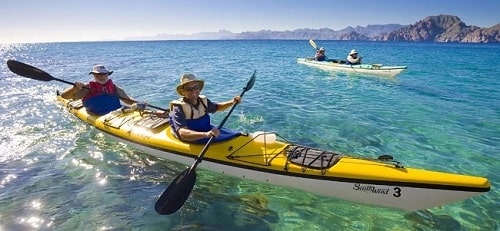
- Mediterranean Sea: It is renowned for its calm and crystal-clear water, suitable for beginners. One significant benefit is it provides a range of destinations.
- Adriatic Sea: It is suitable for experiencing nature’s beauty; it holds many beautiful islands with calm water bays and some hidden caves.
- Caribbean Sea: It is famous as a synonym of paradise; it offers warm turquoise water, sandy beaches, and some Islands popular for canoeing.
- Estuaries: It offers a blend of saltwater and freshwater, mixing with many unique plant and animal habitats. It also enfolds some beauties of nature like river meeting sea and calm water.
- Norwegian Fjords: It encloses waterfalls and some other beautiful wildlife. Towering cliffs and snowcapped peaks surround waterfalls. These make these waterfalls more beautiful.
- Gulf of Mexico: It offers enormous coastal landscapes containing pristine beaches, marshlands, and barrier islands. Canoeing will provide several opportunities to explore coastal areas.
- Chesapeake Bay: It provides an attractive and peaceful environment for canoeing. Chesapeake Bay is the largest estuary in the country. Canoeing offers an exploration of several historic sites and many other natural beauties.
These were some Seas popular for canoeing. As nature can flick so, safety should be the priority. While ensuring safety for canoeing in the ocean, the license will also be as essential.
Let’s know if you need a license to canoe on sea.
Do I Need a License to Canoe in the Sea?
Besides focusing on safety, it is important to follow the rules and regulations of the states where you plan to go canoeing. The question that often arises after reviewing the rules and regulations is: do I need a license to Canoe in the Sea?
It is not a simple “yes” or “no” response, as several factors come into play when determining whether you need a license to canoe in the ocean.
The need for a canoeing license differs among states due to variations in jurisdictional regulations. However, many states do not require a License for non-motorized canoeing. Moreover, some states have licensing requirements.
In nearly all states, motorized canoes are required to be registered and licensed.
Some states that didn’t require canoeing licenses are Alabama, Lowa, Florida, etc. And these states require licenses for canoeing Wisconsin, Ohio, Minnesota, etc.
The type of a canoe plays a pivotal role in ocean canoeing, as it significantly influences performance and functionality in the challenging ocean environment. Now let’s discuss types of canoes and their suitability for ocean use.
Types of canoes and their suitability for ocean use – which one is best?
When we talk about canoeing in the ocean, the type of canoe plays a significant role. In this topic we will only cover designs which are important for ocean canoeing. As we have covered all types in our article; Types of Canoes.
Now let’s read what types of canoes are suitable for ocean use.
Outrigger Canoes: They are popular in Pacific Islands; they contain outrigger floats on one side. It provides stability on rough water currents.
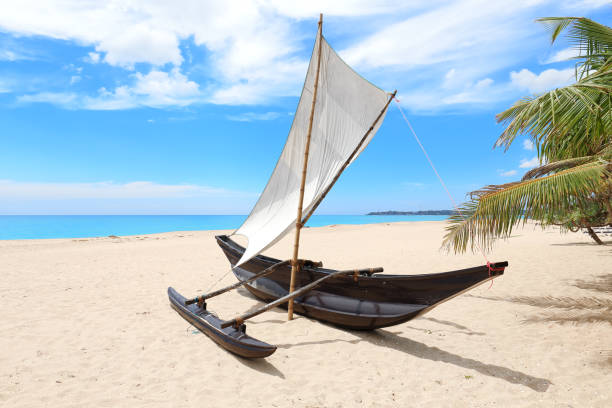
Surf Skis: They are narrow and lightweight canoes, initially built for fast-paced paddling. They are most commonly used for racing and surfing in coastal areas.
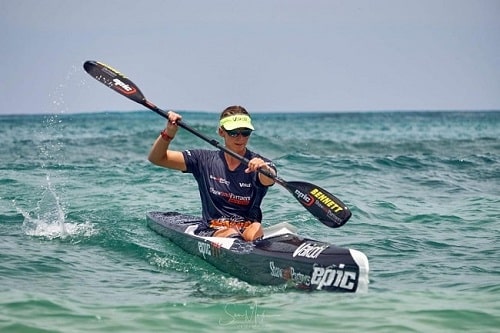
Touring Canoes: They are built for long distance-paddling. They also provide stability and speed, making them perfect for touring purposes.
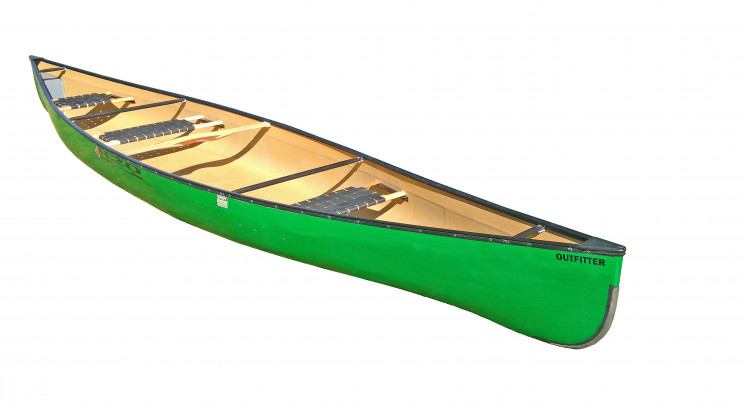
Polynesian Voyaging Canoes: The most famous Polynesian Voyaging Canoe is “Hokulea”. Do you have heard a canoe make a journey around the World? Yes! This is true, the name of that canoe is Hokulea. This type of canoe is double-hulled canoes which makes them perfect for long ocean journeys.
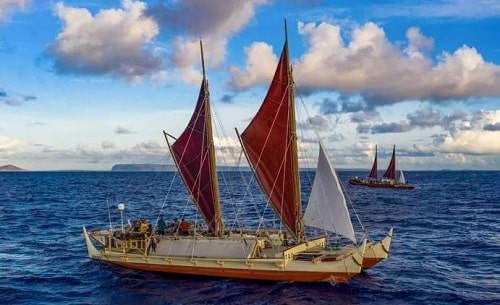
Utilizing these types of canoes designed explicitly for ocean use can significantly enhance the stability, ease, and reliability of your ocean canoeing experience. Incorporating these well-suited canoes ensures a smoother and more enjoyable journey on the open waters.
How to Canoe in the Ocean? We will provide a step-by-step guide to make it easier for you to learn and understand the process of ocean canoeing.
How to Canoe in the Ocean (step-by-step):
Ocean canoeing can be a challenging and potentially hazardous activity. However, specific steps can help you handle a canoe in this environment and increase your confidence and skills.
If you are a beginner then you should know how to steer a Canoe beginners guide. To survive challenges in the Ocean.
Steps for canoeing in the Ocean:
- First up, you need to understand the tide and tidal currents, so you can navigate the ocean safely.
- Next, learn to read a marine chart to know the ocean’s topography and plan your route accordingly.
- When canoeing in the ocean, stay near the coastline for safety and as a point of reference.
- To ensure stability, ballast the canoe by adjusting the weight distribution properly.
- Maintain a proper posture while paddling to stay comfortable, stable, and in control.
- Last but not least, stay hydrated, and wear sunscreen and a hat to protect yourself from the sun’s rays during your ocean canoeing adventure.
These steps are essential to remember and greatly benefit you during your ocean canoeing adventures.
Paddling Guide for Canoeing in Oceans:
To efficiently navigate the ocean in a canoe, practicing various strokes that conserve energy, optimize time, and provide assistance during emergencies is important.
1. Selecting the right paddle for ocean canoeing is crucial. Look for a lightweight paddle designed for efficient propulsion; factors such as length, blade shape, and material to ensure optimal performance on the water must be noted.
2. The low brace technique in canoeing involves placing your paddle horizontally on the water’s surface to enhance stability and prevent capsizing. It is particularly beneficial when dealing with strong tidal conditions.
3. It would help if you learned the forward stroke technique, which involves proper hand placement. It also enhances sore muscles which are involved in this technique.
4. The J stroke is a paddle technique that keeps a canoe on a straight path without constantly switching sides. It ensures a more consistent and efficient paddling experience.
Mastering these different strokes will undoubtedly enhance your canoeing skills.
Does Hull Design Affect the Performance of A Canoe in the Ocean?
Yes! The hull design of a canoe plays a crucial role in its performance and suitability for ocean canoeing. There are six main hull designs with their unique ability. Some are made for stability, some for speed, etc.
| Hull Design | Function |
| Flat Bottom Hull: | While providing stability, it compromises speed and flexibility. It is suitable for calm and shallow water. |
| V-Shaped Hull: | It provides better speed with tracking ability. It offers much stability in many water conditions in the ocean (except in the extreme). |
| Rounded Bottom Hull: | It provides better flexibility and responsiveness. Even though it is stable in moderate water conditions, it cannot bear high ocean currents and become less stable. |
| Multi-Chine Hull: | It provides flexibility, speed and balance stability, which make it perform best in a variety of conditions of the Ocean. |
| Shallow Arch Hull: | It Provides much better stability and speed. In terms of rough water, it lacks stability. |
| Modified Hull Designs: | Some canoes, like Keel and Skegs, have unique hull designs, improving stability and speed. |
These were some hull designs; let’s explore which ones are suitable for ocean use and which are not.
Two hull designs commonly used for ocean canoeing are the V-shaped and Multi-chine hull. These designs are preferred due to their ability to offer stability, flexibility, and increased speed.
Modified Hull and shallow arch hull designs can be suitable options for moderate conditions, but they may not perform well in high water currents.
Rounded and flat bottom hulls are unsuitable for ocean canoeing as they need more stability to navigate ocean conditions.
However, flat-bottom hull canoes are most common in many states. And there is a competition of flat bottom canoe vs keel canoe.
My Personal Tips Regarding Ocean Canoeing:
Now, I will prefer my tips for ocean canoeing. These might come in handy for you.
In my opinion, Outrigger Canoes and Polynesian Voyaging Canoes are best for ocean use. They provide stability and flexibility to handle ocean conditions.
In preference for hull design, V-shaped hull are best. Due to their stability, flexibility, and ability for cutting through the water efficiently.
When selecting a location for ocean canoeing, it is a personal preference. However, I recommend considering estuaries, which offer a unique combination of river and ocean views while providing a safer environment than open seas. Chesapeake Bay is also an excellent choice, blending historical sites and coastal beauty.
Now let’s explore safety measures for ocean canoeing to ensure preparedness in case of emergencies.
Safety Measures for Ocean Canoeing:
Is canoeing Dangerous? Canoeing in the ocean can be potentially dangerous, but following proper safety measures can prevent injuries and minimize risks.
Look at some essential safety tips for canoeing in the ocean to help keep you safe and enjoy your experience.
· Always wear registered personal flotation devices (PFD); they provide much better safety.
· To ensure a safe journey, you must check weather conditions before departure.
· Must carry essential safety measures, such as a flashlight, flare, first-aid kit, etc.
· In challenging conditions, you should leash your paddle to secure it and prevent loss.
· It would be best to leash your paddle in challenging conditions to secure it and prevent loss.
· When canoeing, use caution and be alert if you encounter offshore winds and strong currents. These extreme conditions can make paddling difficult and dangerous.
· Also, practice self-rescue techniques, such as re-entering the canoe if you capsize it.
· We should respect all marine lives and habitats by observing them from a safe distance.
When canoeing in the ocean, it is vital to remember these essential safety measures for a secure experience on the water.
Checklist of Helpful Safety Gear for Ocean Canoeing:
Here is a checklist of some helpful safety gears while canoeing in the ocean.
1. Personal Flotation Devices (PFD).
2. Marine Radio and waterproof mobile case.
3. Marine chart and compass.
4. First-aid kit.
5. Some flares or signaling mirrors.
6. Bilge pump and paddle leash.
7. Duct tapes
Here’s a checklist of essential safety gear required for ocean canoeing.
What challenges you can face while canoeing in the Ocean?
This is a list of some common challenges which are usually faced while canoeing in the ocean.
1. Strong currents and tides.
2. Unpredictable weather conditions.
3. Rough waves and swells.
4. Navigational difficulty.
5. And exposure to sun, wind and elements.
These are some challenges to ensure a prepared mindset and effective handling.
Best Alternative to Ocean Canoe:
Ocean canoeing is weather-dependent and can lack stability during rainy or windy conditions.
As an excellent alternative, kayaks are designed to handle such situations, including high tides.
Sea kayaks are specifically crafted for ocean exploration, as demonstrated by Aleksander Doba, who successfully kayaked the Atlantic Ocean thrice at 70. Kayaks provide a reliable and stable option for challenging ocean environments.
FAQs – Can Canoes Go In The Ocean
Should you add an Outrigger to a Canoe?
Outriggers can be added to canoes for increased stability, especially in rough waters.
Where should a heavier person sit on a canoe?
Heavier individuals should sit closer to the canoe’s center to maintain balance.
Can one person use a canoe in the ocean if he’s a beginner?
It is recommended for beginners to have some experience before canoeing alone in the ocean.
How do I navigate around waves and swells while ocean canoeing?
Navigate waves and swells by paddling parallel to them and using proper bracing techniques.
Can I encounter marine wildlife while canoeing in the ocean, and how should I handle those situations?
Encountering marine wildlife is possible; maintain a respectful distance to avoid disturbing them.
Can I use a motorized trolling motor with my ocean canoe?
Motorized trolling motors can be used with ocean canoes if permitted by local regulations.
Are there specific areas or coastal regions more suitable for ocean canoeing?
Some coastal areas have more favorable conditions for ocean canoeing; research and local knowledge are essential.
Can a traditional canoe be used in the ocean or saltwater?
Traditional canoes can be used in the ocean or saltwater, but it’s important to consider their design and capabilities.

Passionate freelance writer and certified boat captain, Sam brings his expertise to this pedal boating & Canoeing blog. With a knack for captivating storytelling and in-depth knowledge of boating regulations, he’s here to make your boating experience even more enjoyable and informed.
